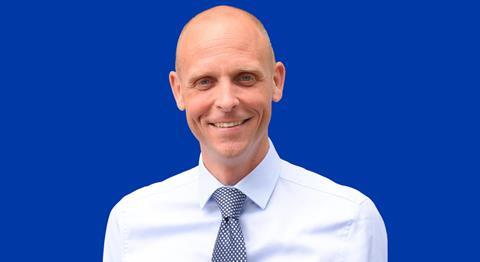In the second of our Wider View articles with H.B. Fuller for 2024, we look in-depth at the company’s Advantra® Earthic™ 9500 hot-melt adhesive for cases and cartons – and its implications for the industry’s shared sustainability goals.
The first of our Wider View series with H.B. Fuller this year explored the reasons behind the lack of high-quality rPET on the market and why choosing the right adhesives is crucial from both an economic and an environmental perspective. This time, we are going to go a little more granular, moving from rPET to look at a specific solution for bonding cases and cartons: Advantra® Earthic™ 9500. This product is a hot melt adhesive designed to help users meet their efficiency and environmental goals.
“This development was started many years ago by our global R&D team based on a market trend in the industry to track adhesive consumption in the plant,” says Adrian Day, H.B. Fuller Global Market Segment Leader for End of Line Packaging and Graphic Arts, explaining the impetus behind the development of the solution. “Customers are always looking for ways to improve the efficiency of their operations, and the total cost of ownership of their packaging is a relevant metric to measure.” From a technology perspective, following the market trend moving from EVA to metallocene based hot melts, H.B. Fuller says that Advantra® Earthic™ 9500 represents the next step with further mileage savings.
“How to do more with less is the challenge that Advantra® Earthic™ 9500 was developed to meet. And for us it is very gratifying to see great examples of customers around the world with significant adhesive savings exceeding our target of 25%, with some examples achieving up to 37% savings,” says Adrian Day.
We will look more at the environmental benefits Advantra® Earthic™ 9500 brings and use it as a lens through which to explore the wider environmental agenda of the packaging value chain.
Meeting the industry’s sustainability challenges
The sustainability challenges faced by all packagers are manifold, including reducing energy consumption, improving production efficiency, reducing the amount of adhesive and material used – all while ensuring recyclability at end of life. Each challenge of course requires a different approach, but what they have in common is that choosing the right adhesives can help move a step further towards those sustainability end-goals.
And that word ‘step’ really is the operative one here. “At H.B. Fuller, we help customers consider incremental changes before completely redesigning the overall packaging,” Adrian says.
So how does making this seemingly small change of switching to a new adhesive relate to the environmental targets of the industry as a whole?
“The Advantra® product range facilitates the repulpability process, which means that during the paper recycling process the adhesive does not affect the recycling stream, and Earthic™ 9500 is no different,” Adrian says. “In addition, Advantra® Earthic™ 9500 offers a lower carbon footprint impact by significantly reducing the amount of adhesive required to do the same job. Based on our internal data, we know it has an impact of only 1.8 to 2.1 CO₂ e/kg, while the industry average for hot melts is between 2 and 5 CO₂ e/kg.”
In short, says Adrian, “This new breakthrough technology will enable brand owners to reduce their adhesive consumption while closing more cartons with less adhesive, and by reducing the overall packaging materials they will also achieve savings in the carbon footprint of their packaging and operations.”
Case study: Advantra® Earthic™ 9500 in action
H.B. Fuller says that Advantra® Earthic™ 9500 can be applied to any regular case or carton substrate, and furthermore works even on more challenging surfaces such as frozen food packaging while also ensuring food safety with low migration potential. According to H.B. Fuller, internal studies confirm that 100 kg of the adhesive can seal 89,000 cartons, compared to 66,667 cartons with other state-of-the-art hot melt adhesives. By switching to Advantra® Earthic™ 9500, this company is saving 90kg of CO₂ emissions per year. This is the equivalent of driving 371 kilometres in a car.
To give a real-world example of how this solution is implemented: the company recently worked with a major food manufacturer in the U.S. that was looking to improve its carton sealing for frozen foods using less material. There was an additional challenge of overstuffed cartons after sealing. After implementing Advantra® Earthic™ 9500, in addition to monitoring the manufacturer’s lines using H.B. Fuller’s FullVision® system to increase accuracy, the customer reportedly found a 37% reduction in adhesive consumption compared to the previous product they had used.
“As we advance towards the circular economy, our customers will be looking more closely at the overall packaging design and what fundamental changes can be made,” says Adrian “That’s where our collaboration and design innovation really come in – to find the appropriate solution for each customer and make the biggest impact.”
The importance of design
Up to this point, we have talked about how one particular solution serves as an example of how a company can begin to tackle the most common environmental challenges they face by making incremental changes. But we wanted to know what other considerations companies should make in that vital packaging development phase:
“When thinking about the next-generation packaging, the goal is for brand owners to understand the full lifecycle of packaging – be it carton board, glass bottles or flexible packaging – from production, consumption, disposal to recyclability at the end of each product’s life,” Adrian says. “This includes not only primary packaging but also secondary and tertiary packaging to reduce material throughout the supply chain without compromising transport and storage performance.”

He added, “Consumers continue to say they won’t buy from a brand whose packaging is not sustainable. As a result, we are seeing more brands redesigning their packaging to meet these expectations, looking for solutions that reduce packaging materials, allow for reuse, and make recycling easy and intuitive for consumers. In addition, packaging must deliver a great customer experience and reflect their brand values.”
Building change through collaboration
It’s clear that for Adrian, as for almost everybody we talk to about sustainability in the packaging industry, collaboration is the key to progress. This can mean both smaller collaborations between a customer and provider (such as in the case study above) or more high-level, industry-wide or even global alliances to build systems change.
“Collaboration across the supply chain is essential if we are to make the changes that will make the world a better place for the next generation of consumers”
“Collaboration across the supply chain is essential if we are to make the changes that will make the world a better place for the next generation of consumers,” he says “Being more sustainable can mean different things to different people. It could mean being easy to recycle. Or having a low carbon footprint. Or being designed using circular economy principles. But most likely it will be a combination of all of these, in addition to complying with current and possible future regulations.”
What’s next on the agenda?
The above demonstrates to our readers the importance of making a considered choice when it comes to the often-overlooked elements of a packaging design such as bonding agents. Following the launch of Advantra® Earthic™ 9500, what is next on the innovation agenda for H.B. Fuller?
“We have multiple projects involving our scientists designing and engineering technologies that contribute to the circular economy and help our customers ‘reduce, reuse and recycle’, ranging from formulating adhesives using bio-sourced raw materials through to developing new, naturally, and responsibly sourced adhesive raw materials,” says Adrian.
Make sure to follow the news on the Packaging Europe website in the coming months and years for updates on what these technologies might be. Companies wanting to know more about Advantra® Earthic™ 9500 and get advice on how to develop the most economical, sustainable packaging format for their products, can speak to a member of the team today at AdhesiveExperts.EU@hbfuller.com.


This premium feature brings a completely new way for you to interact with our audience through a combination of collaborative editorial and premium promotion. An article written together between you and Packaging Europe’s content team, The Wider View will have a dedicated widget across all web pages & eNewsletter, and will link to a stunning, long-format web page put together by our design team featuring your graphics and branding. Carrying no other advertising, and pushing the limits of ordinary web communications, this is the ultimate digital content package




















No comments yet